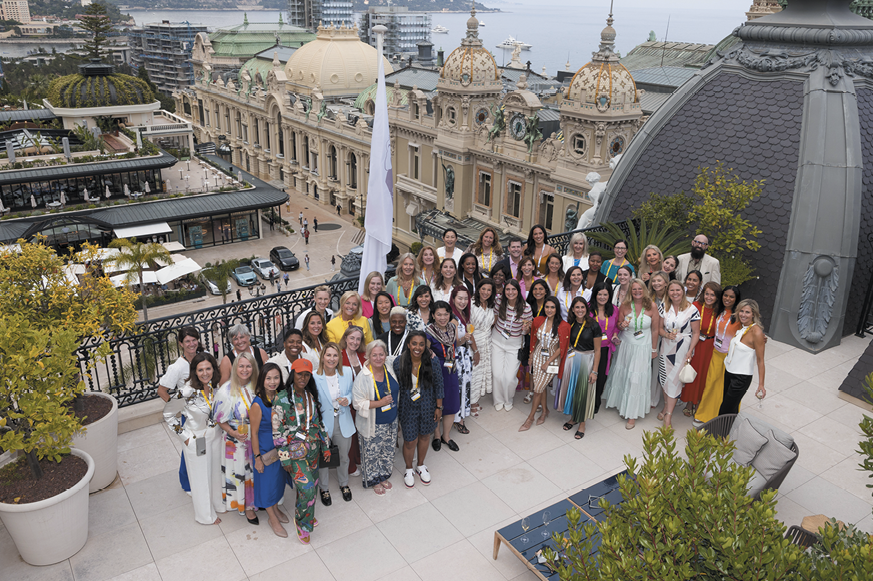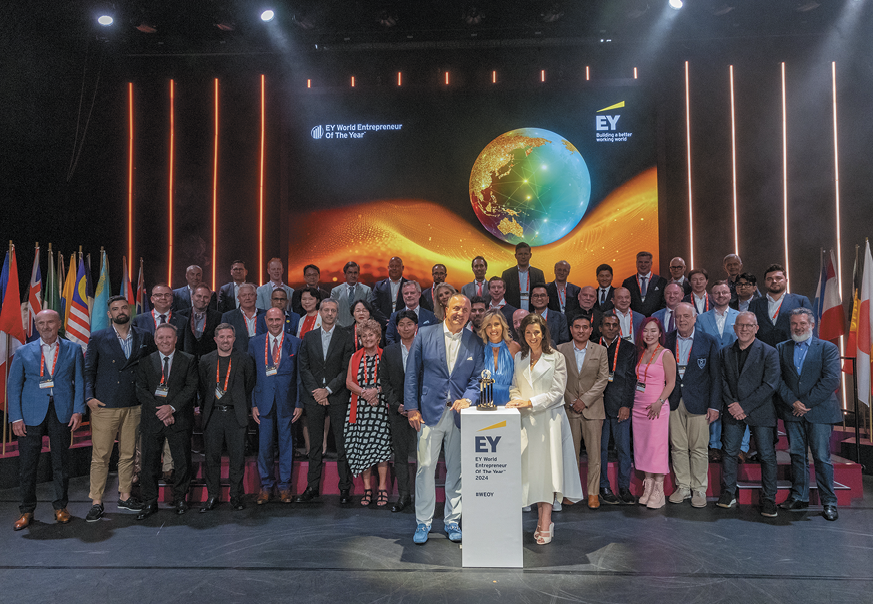- Home
- Media Kit
- MediaJet
- Current Issue
- Past Issues
- Ad Specs-Submission
- Reprints (PDF)
- Photo Specifications (PDF)
- Contact Us
- PRIVACY POLICY
- TERMS OF USE
![]()
ONLINE
![]()
ONLINE

“All In”
Editors’ Note
Janet Truncale is the EY Global Chair and Chief Executive Officer, leading one of the world’s largest professional services organizations with 400,000 people across 150 countries. Prior to her election, Truncale served as EY Vice Chair and Regional Managing Partner of the EY Americas Financial Services Organization (FSO), where she led a diverse team of over 14,000 professionals across 90 offices. Throughout her career, Truncale has provided assurance and consulting services to leading Fortune 500 companies, and has worked closely with boards, audit committees, and senior management to resolve the most complex business issues. She has served as the Global Client Service Partner and Senior Advisory Partner to many of EY’s largest clients. Truncale joined EY as an intern, and has served in a wide variety of roles, including as EY Americas FSO Assurance Managing Partner, Banking and Capital Markets Co-Sector Leader and Initial Public Offering Leader. She is a certified public accountant in New York and a member of the American Institute of Certified Public Accountants. She has been named by the Financial Times as one of the “25 Most Influential Women.” Truncale co-chairs the EY Global Diversity, Equity and Inclusiveness Steering Committee, which works to provide access to inclusive and equitable experiences across the organization. As a member of the EY Global Social Equity Task Force, Truncale has played an important role in the development and launch of the EY ‘Uplift’ campaign and of other social equity initiatives across the organization. In addition, she has served as the executive sponsor of the EY US Veterans Network. Outside of the EY organization, Truncale serves as a Board Chair for Women’s World Banking, and is on the board of UNICEF USA, and the US-China Business Council. She also serves as one of the co-chairs of the New York Jobs CEO Council. She is a member of the Washington DC-based US Business Roundtable and of the World Economic Forum International Business Council. Truncale received her BSE from The Wharton School of the University of Pennsylvania and has an MBA from Columbia University.
Company Brief
EY (ey.com) exists to build a better working world, helping to create long-term value for clients, people, and society and build trust in the capital markets. Enabled by data and technology, diverse EY teams in over 150 countries provide trust through assurance and help clients grow, transform, and operate. Working across assurance, consulting, law, strategy, tax and transactions, EY teams ask better questions to find new answers for the complex issues facing our world today.

Janet Truncale toasting with women entrepreneurs
at the EY World Entrepreneur of the Year event
Will you discuss your career journey at EY?
Who would have thought when I joined EY as an intern that one day I’d be doing this interview? Over my 30 years at EY, I have provided assurance and consulting services to leading Fortune 500 companies and worked with boards, audit committees, and senior management to resolve complex business issues. In an organization of nearly 400,000 people doing $50 billion in revenue of work across an array of businesses and sectors, there’s endless opportunity to learn and grow. Every role I had was preparing me for the next one. I was always focused on doing my best and being “in the moment.”
Last year, when our organization began the Global Chair and CEO selection process, EY was at an inflection point. I was humbled that our partners thought my skills and experiences fit the moment in time and elected me to the role. I’m often reminded that I am the first woman to lead a Big Four firm globally. I have heard from many around the world – men and women – that the appointment gives them confidence in their own career opportunities. I am moved by these sentiments.
“Through ‘All in,’ we’re launching our new employee value proposition, ‘Shape YOUR future with confidence.’ It will build upon a robust foundation and focus on new ways to grow professionally, support well-being, and further drive a culture of inclusiveness and belonging.”
How did you approach the transition to your new role as EY Global Chair and Chief Executive Officer?
I was fortunate to have a robust transition period alongside my predecessor, Carmine Di Sibio. We share a passion for client service and being with our people. On the client side, we transitioned hundreds of relationships with CEOs and other senior executives across the world’s largest, most influential organizations. Those discussions inevitably end up on similar topics – volatile geopolitics, pace of technology change, and the evolving dynamic of the workforce – all market disruptions that we at EY are focused on as well. Internally, I wanted to get “under the hood” of our business and understand how best we could leverage EY’s globally connected teams to help our clients capitalize on the opportunity these disruptive forces can also bring.
How do you define EY’s culture and values?
In my conversations with EY people at all levels, there is a clear passion to succeed in the market and a belief in the strength of our organization. I’ve always felt our client-centric and driven culture was one of EY’s principal strengths. Our people live our values by demonstrating integrity, respect, and inclusiveness. It’s the groundwork for strong teams where our people trust each other and have each other’s backs. In this type of teaming environment, our people are empowered to challenge the status quo. They are encouraged to reach across service lines and sectors to bring thoughtful, holistic solutions to our clients’ complex challenges.
We are at our best when we bring together our diverse talent to solve the most complex and interconnected issues. As a result, EY is known for collaboration. It’s a strength and differentiator that I have always been proud of. Clients have noticed our remarkable teams and even asked me how they can replicate our success in their own organizations.
“EY’s longtime support for entrepreneurs is part of our legacy. Our work with entrepreneurs changes lives, a poignant example of our purpose of Building a Better Working World.”
What do you attribute EY’s industry leadership to and how do you describe the EY difference?
EY has had an extraordinarily successful period of market leading growth – roughly doubling in size over the last ten years. But as the landscape around us changes, our clients need the combination of our highly skilled, multi-disciplinary workforce and expansive global footprint to help them address increasingly complex challenges. Our people deliver our services with speed and efficiency – augmented by the EY.ai platform – to help our clients shape the future. To maintain our leadership in the industry, it is also vital that we make intentional, disciplined choices. We have to stay future-focused, which means leaning into new areas in which we are seeing clear client demand. This includes transformation, managed services and sustainability, all fueled by investments in technology. Of equal importance, we will continue to place an unwavering commitment to audit quality. I take our responsibility to uphold confidence in capital markets seriously. It will help ensure we continue to capitalize on our competitive advantages while focusing on the future.
“The best way to predict the future is to create it, and that takes confidence. We are not the same organization that we were ten or even five years ago. Neither are our clients. We will harness the capabilities, skills, and advice of our teams to create new value for our clients, people, and society – all against the backdrop of unprecedented complexity and speed of change.”
What does EY’s new strategy, “All in” mean inside/outside the firm and how is EY delivering on its purpose to shape the future with confidence?
The best way to predict the future is to create it, and that takes confidence. We are not the same organization that we were ten or even five years ago. Neither are our clients. We will harness the capabilities, skills, and advice of our teams to create new value for our clients, people, and society – all against the backdrop of unprecedented complexity and speed of change. Since we launched the new strategy, “All in” quickly became part of the vernacular. The concept was highly resonant with our people at a time when they wanted something to galvanize around. I have received hundreds of positive messages from colleagues around the globe – EY people say they are excited, committed, and empowered. One example is from a partner who was on his way to a new client pitch when his flight was cancelled. He drove eight hours to be with the team on time. A picture of his road trip and his “All in” commitment made its way to me. That was inspiring to see. I hear stories like that all the time now.

Janet Truncale joined by the Class of 2024
EY World Entrepreneur of the Year finalists
EY has been a leader in supporting entrepreneurs and fostering entrepreneurship. What has made this focus so important for the firm?
EY’s longtime support for entrepreneurs is part of our legacy. Our work with entrepreneurs changes lives, a poignant example of our purpose of Building a Better Working World. A few months after my appointment, I had the privilege of attending our annual EY World Entrepreneur Of The Year™ (WEOY) event for the first time. WEOY convenes founders, transformative CEOs and business leaders in the ultimate global competition for entrepreneurs. The WEOY 2024 class represented combined revenues of $27.4 billion and 105,000 collective jobs. They all had inspiring stories of perseverance, reliance, and innovation. Seeing their collective impact was very powerful.
Entrepreneurs are the ones taking risks. As one finalist said at the gala, “We are the square pegs in round holes.” That may be true, but they are also creating jobs and building the future.
You championed EY’s latest push on social mobility. Why did you choose to prioritize this topic?
At EY, we view diversity, equity, and inclusiveness as business imperatives. We seek to maximize the power of all differences, which drives innovation and creates competitive advantages. Socio-economic background is often overlooked as a dimension of diversity at work. We recognize that our people come from a variety of starting places that shape the experiences and barriers we might face. I want everybody to feel they have the same potential. Our social mobility campaign is about driving awareness, so our people see inequity and actively open doors for people across all backgrounds.
One of our most senior partners, Josh, talks about his upbringing in a campaign video. He describes his childhood in a poor farming community in Iowa, never meeting his father and grappling with a mom who struggled with addiction. He had an internal drive that led him to go to college and change the trajectory of his life. He views his past as an asset at work. Josh said, “When I interview people now, I see different things because I know there is potential there for solving the problems and being able to manage a lot of complexity.” I think about Josh’s story a lot – and I’m happy we have him to help us identify great future talent.
“At EY, we view diversity, equity, and inclusiveness
as business imperatives. We seek to maximize the
power of all differences, which drives innovation and creates competitive advantages.”
Artificial intelligence is being adopted at an increasing pace. Where do you see the greatest opportunity for the technology?
Again, many of the issues facing our clients are ones we face as well. We want to enable our businesses with AI, so we think of ourselves as “Client Zero.” This requires confidence in the possibilities and use cases for AI – and will continue to help us lead our clients through their own transformation journeys. We believe the greatest opportunity for AI is when it is working hand in hand with people. That’s why we’re taking a skills-based approach to learning, rolling out AI training to all EY people, which has been completed by over 250,000 to date. As leaders, we also need to understand the consequences of AI adoption and collaborate to address them. We need to understand impact to the workforce, how best to keep upskilling people, while also working with stakeholders to ensure the right guardrails are in place so that AI is being employed for good.
A significant part of EY’s work on AI to date has been helping clients drive transformation while embedding responsible practices. This means considering how AI is being used while assessing ethical and security risks, and regulatory compliance. Additionally, EY has adopted its own AI Principles, which take into account our experience working with the technology for many years – including accountability, data protection, and transparency.
AI will continue to supercharge our ability to serve our clients. Last year, we rolled out EY.ai, which brought all of EY’s AI efforts under a single platform, and today is being actively used by over 80,000 clients.

Janet Truncale and Carmine Di Sibio,
former EY Global Chairman and CEO,
at the EY Innovation Realized Global Summit
With nearly 400,000 people across 150 geographies, how are you adapting EY’s talent strategy to meet the changing needs of the workforce?
Our people shut down each day, and we want them to want to come back every morning. We’re constantly evaluating what today’s EY professional needs to thrive. Through “All in,” we’re launching our new employee value proposition, “Shape YOUR future with confidence.” It will build upon a robust foundation and focus on new ways to grow professionally, support well-being, and further drive a culture of inclusiveness and belonging. We will always have a strong point of view on talent because our business is our people. Whether it is our approach to learning and development, the benefits we provide or our focus on values, we pride ourselves on being market-leading and plan to stay that way.
Having started at EY as an intern and progressed to the top leadership role, what is your advice on building teams and leading through times of uncertainty?
First, consider who is in your immediate circle. I have always sought out people who challenge me to raise my game and bring new perspective. I have always valued my “truthtellers” and as my career has advanced, those relationships have become even more important. These are ones who I trust to help me see my blind spots and challenge my thinking, especially in tough times.
When it comes to building teams, strive for complementary, not “cookie cutter.” When I reflect on the teams I have led at EY, the most productive – and fun – were the ones where we could have lively debate across different opinions. As a leader, my decisions don’t need consensus – it’s impossible to always get there – but they do need alignment. I believe an open and engaging process is critical to getting the team aligned behind the choices you make. And ultimately, the best outcomes are when we are all executing together.![]()